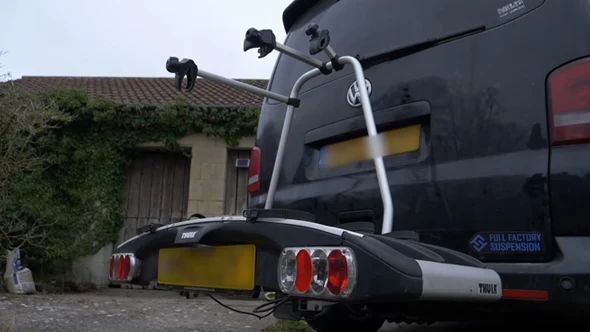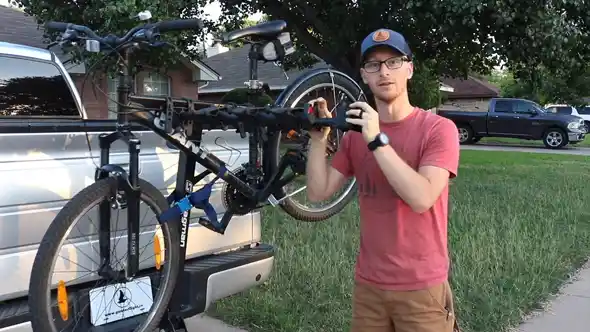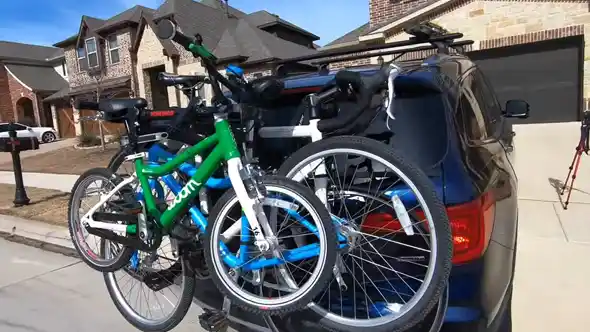On a road trip, you want to take your bike, but you’re unsure if you can leave your bike rack behind. The short answer is yes; you can leave your bicycle carrier on your car.
Whether you’re planning on doing some serious biking or just want to have the option while you’re on vacation, bringing your bike rack along for the ride is a smart idea. You need to take a few precautions to avoid injuring your car.
If you have a roof rack, ensure that the bike rack is properly secured and that the bikes are not obstructing your view. It’s also a good idea to cover the bikes with a tarp or blanket to protect them from the elements.
Can I Leave My Bike Rack on My Car: Simple Guide

If you’re concerned that leaving your bicycle rack on your car is safe, you could risk your vehicle. It’s generally safe to leave a bike rack on the automobile the right way.
A bike rack can add a lot of extra weight to your car. It shouldn’t come loose while driving. You’ll need to consider how much wind resistance your bike rack will create. The more wind resistance, the more fuel your car will use.
Don’t forget to secure your bike rack to your car. Otherwise, you risk it coming dangling, causing friction, scratching your paint, or even causing an accident if it doesn’t.
If you’re still uncertain, consult the manual for your specific make and model. Many carmakers will have a section that addresses leaving items like a bike rack on top of the vehicle. You can also check with local laws to see.
Are Bike Racks Easy to Remove from The Car?
If you have a hitch-mounted rack, they are much easier to take on and off. You can do it by yourself in just a few minutes. Many bike racks can be folded for compact storage, making them even easier to keep out of the way. Most models will have a quick-release system that makes it simple to remove the rack when you’re not using it.
Anyone who has ever tried to remove a roof-mounted rack from a car knows it can be notoriously difficult to take off. In many cases, the racks are too tight to remove by hand.
You need to go up on the roof, unbolt it with a plier or an Allen wrench, and then try to maneuver it down awkwardly. This is incredibly challenging if you’re doing it by yourself. You can try spraying the bolts with lubricant, which can help to break the bond between the metal and the rack.
Sometimes, you need to use a roof ladder, and if you’re not comfortable doing that, then you shouldn’t be removing the rack by yourself in the first place. It’s always best to have someone else help you with this task.
Do Bike Racks Get Stolen from Cars?
It is always possible for your bike rack to be stolen if it is mounted on your car. After all, bike racks are valuable equipment and are often left unattended in public places.
You can prevent your bike rack from being stolen by doing a few things. Choose a high-quality bike rack designed to be challenging to break into. Always lock your wheel to the carrier with a bike rack lock whenever you’re not using it.
Park in a well-lit and well-populated area or garage whenever possible. Taking these precautions can help reduce the risk of having your bike rack stolen.
How Do You Lock Your Bike Rack to the Hitch?

The best way to do this is with a U-lock, a type of lock that fits around the frame of your bike and the hitch of your rack. There are two main ways to use a U-lock: either by threading the U-lock through the front wheel and back wheel of your bike or by threading it through the front wheel and the frame of your rack. The process is as follows:
Step 1: Remove any attachments from the rack that could be used to cut through the lock. This includes quick-release wheels, pedals, and water bottles.
Step 2: Position the rack, so the crossbar is closest to the hitch receiver. This will make it more difficult for someone to remove the rack from the car.
Step 3: Loop a cable lock or U-lock through the rack frame and around the hitch receiver. If possible, thread the lock through both receiver sides for added security.
Step 4: Secure the lock by running the shackle through both the cable or U-lock loops. Ensure that the shackle is fully inserted into both loops so it can’t be pulled out.
Step 5: Place the bike on the rack and secure it in place with a bike rack lock. If possible, use a locking skewer to secure the front wheel to the frame of the carrier.
How Do You Lock Your Bike to the Roof Rack?
Locking your bike on the roof rack is a great way to secure it while you are away from your vehicle. You can also use a chain and padlock, though this is less secure. Here are some tips on how to do so:
Step 01. Remove any loose items, such as lights or reflectors.
Step 02. Take the front wheel off and place it on the bike rack. Position the bike so that it cannot roll off the rack.
Step 03. Take the back wheel and put it on top of the front wheel. Ensure the brakes are locked so the wheels don’t move.
Step 04. Attach the lock to the frame and a solid part of the rack, such as a crossbar. For extra security, you can also run the cable through the wheels. Close and lock the door to your vehicle.
Step 05. Using a ladder, put the bicycle on the roof rack and secure it with the straps. Make sure the straps are tight so the bike cannot move. Lock the straps to the rack with a padlock or U-lock.
Is It OK to Leave Your Bike Rack Outside in the Winter?

If you live in an area that experiences freezing temperatures and winter snowfall, you may wonder if it’s okay to leave your bike rack outside. The answer depends on some factors, including the type of bike rack you have, the location of the rack, and the amount of snow and ice in your area.
Salt is often used on roads and sidewalks to melt ice and prevent accidents. It can also damage metal surfaces, including bike racks. If you live in an area where road salt is used, it’s best to bring your metal bike rack inside during winter. Otherwise, it’s going to rust
Aluminum racks are a good choice, as they won’t rust or corrode when exposed to moisture. This will help to protect it from road salt and other debris that can accelerate wear and tear.
No need to worry about your plastic bike rack cracking or breaking in the cold weather. Plastic is more resistant to freezing temperatures than metal, so your rack is likely to fare better outdoors than it would if you left it in a garage or shed. It can fade its color, though, so if you’re worried about that, you can store it indoors.
Can You Leave a Bike Rack in the Rain?
Although you may leave it outside, it is not recommended to leave your bicycle rack in the rain as it can lose its original color and even cause rusting. The straps may loosen and allow your bike to fall off. If you must leave your rack in the rain, try to cover it with a plastic sheet to keep it as dry as possible.
Steel Bike Rack:
You can leave a steel bike rack out in the rain, but there are a few things to keep in mind. Steel is susceptible to rusting, so it’s important to ensure that the rack is powder-coated or otherwise treated to resist corrosion. While steel is durable, it can eventually succumb to weathering and wear and tear.
Aluminum Bike Rack:
Aluminum bike racks are one of the most popular types on the market for their durability, lightweight, and they don’t rust. They can be susceptible to damage from weathering and from salt water if they’re not properly cared for.
Plastic Bike Rack:
Unless you have a specific reason to do otherwise, leaving a plastic bicycle carrier out in the rain is generally not a good idea. There are a few potential problems that could occur.
The plastic may become warped or brittle over time, making it less effective at holding bikes. It may start to degrade, leaching chemicals into the environment. The rainwater may pool on the surface of the rack, making it more likely to topple over.
So unless you have a good reason to leave your bicycle carrier out in the rain, it’s best to bring it inside or store it in a dry, protected location.
Can You Put a Bike Rack on a Car without a Hitch?

There are a variety of ways to transport bikes without a hitch bike rack, including cargo boxes, trunk bike racks, truck bed bike racks, and spare-tire bike racks. Each has its own pros and cons, so choosing the option that best fits your needs is important.
Cargo boxes are great for carrying multiple bikes or for transporting bikes with unusual dimensions (such as tandem bikes). They can be expensive and can make your car less fuel-efficient.
Trunk racks are more economical but can be challenging to install and may not work with all car models. They are ideal for pick-up trucks, but they can make it difficult to access the beds of your vehicle.
Spare-tire bike racks are perhaps the most versatile option, as they can be used on most vehicles and don’t require any permanent installation. They may not be able to accommodate larger bikes or multiple bikes. Ultimately, there is no “one size fits all” solution for transporting bikes without a hitch-mounted bike rack.
What Kind Of Bike Rack Is Easiest To Use?
Some bike racks are mounted on the front of vehicles, while others are attached to the back. Some racks accommodate multiple bikes, while others are designed for a single bicycle. And some racks are easier to use than others.
When choosing a bike rack, you must consider the type of vehicle you own and the number of bikes you need to transport. A hitch rack is probably your best option if you have a van or pick-up truck. These racks are easy to install and can accommodate multiple bikes.
A trunk mount bike rack may be better if you have a smaller car. These racks are lighter and take up less space when not in use. And if you only need to transport one or two bikes, a roof-mounted bike rack may be the most convenient option.
What Type of Bike Rack is Best for an SUV?
Hitch racks are the most popular type of rack for SUVs. They attach to the trailer hitch, making it quick and easy to install. Most models can carry up to four bikes, and some even have additional features such as a built-in lock or a swing-away design that makes it easy to access the trunk.
These racks are also inexpensive, making them an excellent option for budget-minded travelers. If you frequently take your bikes on long road trips or plan to leave them on the rack for extended periods, a hitch mount rack may not be the best option.
Can You Open Your Trunk With A Bike Rack On It?

If you have a bicycle stand on your car, you might wonder if you can still open your trunk. It is generally best to consult your car’s owner manual or the bike rack’s instructions before opening the trunk with a bike carrier in place.
Most hitch-mounted racks can be tilted away from the car, giving you access to the trunk. Roof-mounted racks are more difficult to remove, and some models may block the trunk entirely. With a roof-mounted rack, you can usually still open the trunk by sliding it forward or by removing the bikes from the rack.
Is It Safe To Travel With A Bike Rack?
There are a lot of factors to consider when deciding whether or not to travel with a bicycle carrier or rack. The most important consideration is the safety of your vehicle and its occupants. If you’re not confident in your ability to secure the rack to your roof bars, it’s probably best to leave it at home.
Another thing to think about is the size and weight of your road bike. Some roof racks are only meant for smaller bikes, so if you have a heavier model, it could damage your car or be more difficult to control on the road.
You’ll need to take into account the weather conditions. Keeping your bike on the rack may be more challenging if it’s windy or icy. Overall, traveling with a car bike rack is safe as long as you are aware of the potential risks and take the necessary precautions.
You Might be Interested:

